Top Rankings
Kansas City 33 School District ranks among the top 20% of public school district in Missouri for:
Category
Attribute
Diversity
Most diverse schools (Top 1%)
Community Size
Largest student body (number of students) (Top 1%)
For the 2025 school year, there are 9 public high schools serving 4,503 students in Kansas City 33 School District. This district's average high testing ranking is 1/10, which is in the bottom 50% of public high schools in Missouri.
ÎÛÎÛÂþ» High Schools in Kansas City 33 School District have an average math proficiency score of 11% (versus the Missouri public high school average of 37%), and reading proficiency score of 32% (versus the 51% statewide average).
ÎÛÎÛÂþ» High School in Kansas City 33 School District have a Graduation Rate of 73%, which is less than the Missouri average of 90%.
The school with highest graduation rate is Lincoln College Prep., with 98% graduation rate. Read more about public school graduation rate statistics in Missouri or national school graduation rate statistics.
Minority enrollment is 90% of the student body (majority Black), which is more than the Missouri public high school average of 30% (majority Black).
Overview
This School District
This State (MO)
# Schools
33 Schools
756 Schools
# Students
14,694 Students
293,742 Students
# Teachers
1,176 Teachers
22,924 Teachers
Student : Teacher Ratio
13:1
13:1
District Rank
Kansas City 33 School District, which is ranked within the bottom 50% of all 553 school districts in Missouri (based off of combined math and reading proficiency testing data) for the 2021-2022 school year.
The school district's graduation rate of 73% has increased from 72% over five school years.
Overall District Rank
#510 out of 557 school districts
(Bottom 50%)
(Bottom 50%)
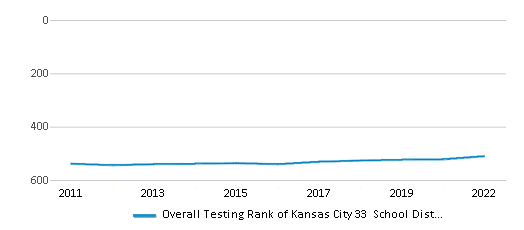
Math Test Scores (% Proficient)
18%
39%
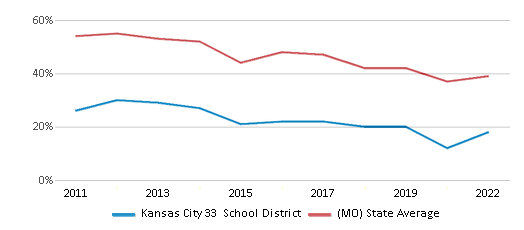
Reading/Language Arts Test Scores (% Proficient)
23%
43%
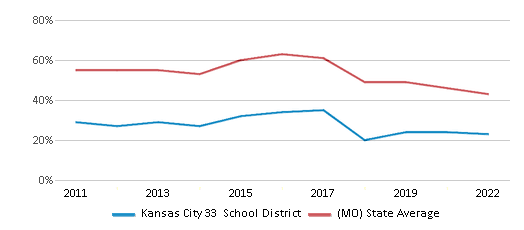
Science Test Scores (% Proficient)
19%
38%
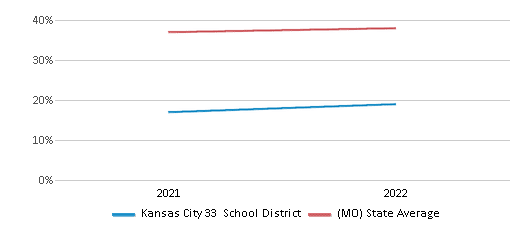
Graduation Rate
73%
90%
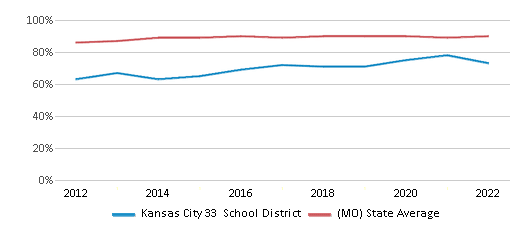
Students by Ethnicity:
Diversity Score
0.65
0.49
# American Indian Students
50 Students
1,120 Students
% American Indian Students
n/a
n/a
# Asian Students
618 Students
6,150 Students
% Asian Students
4%
2%
# Hispanic Students
4,535 Students
23,978 Students
% Hispanic Students
31%
8%
# Black Students
7,361 Students
43,087 Students
% Black Students
50%
15%
# White Students
1,550 Students
204,439 Students
% White Students
11%
70%
# Hawaiian Students
148 Students
1,084 Students
% Hawaiian Students
1%
n/a
# Two or more races Students
432 Students
13,884 Students
% of Two or more races Students
3%
5%
Students by Grade:
# Students in PK Grade:
1,074
1,466
# Students in K Grade:
1,126
315
# Students in 1st Grade:
1,166
366
# Students in 2nd Grade:
1,189
351
# Students in 3rd Grade:
1,045
395
# Students in 4th Grade:
1,067
405
# Students in 5th Grade:
1,066
447
# Students in 6th Grade:
959
2,189
# Students in 7th Grade:
847
6,097
# Students in 8th Grade:
932
6,658
# Students in 9th Grade:
1,151
70,725
# Students in 10th Grade:
1,156
70,444
# Students in 11th Grade:
1,047
68,735
# Students in 12th Grade:
869
65,149
# Ungraded Students:
-
-
District Revenue and Spending
The revenue/student of $19,050 is higher than the state median of $15,081. The school district revenue/student has stayed relatively flat over four school years.
The school district's spending/student of $16,638 is higher than the state median of $13,908. The school district spending/student has stayed relatively flat over four school years.
Total Revenue
$280 MM
$13,447 MM
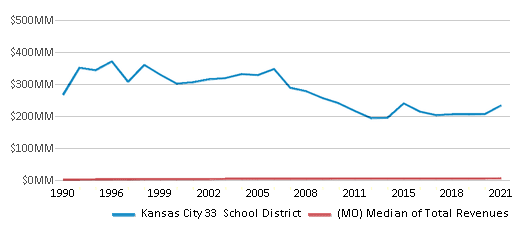
Spending
$245 MM
$12,401 MM
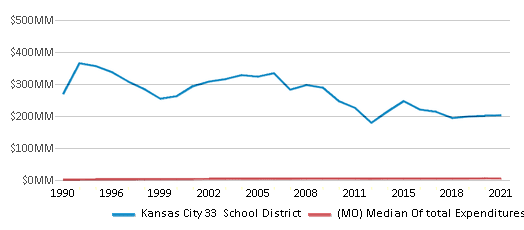
Revenue / Student
$19,050
$15,081
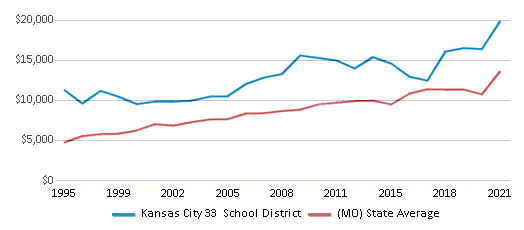
Spending / Student
$16,638
$13,908
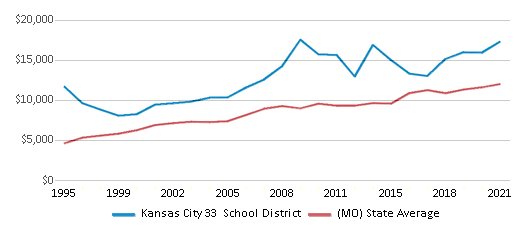
Best Kansas City 33 School District ÎÛÎÛÂþ» High Schools (2025)
School
(Math and Reading Proficiency)
(Math and Reading Proficiency)
Location
Grades
Students
Rank: #11.
Lincoln College Prep.
Magnet School
(Math: 25-29% | Reading: 71%)
Rank:
Rank:
7/
Top 50%10
2111 Woodland
Kansas City, MO 64108
(816) 418-3000
Kansas City, MO 64108
(816) 418-3000
Grades: 9-12
| 958 students
Rank: #22.
Contract
(Math: ≤20% | Reading: ≤20%)
Rank:
Rank:
2/
Bottom 50%10
3708 Linwood
Kansas City, MO 64128
(816) 418-2200
Kansas City, MO 64128
(816) 418-2200
Grades: PK-12
| 40 students
Rank: #33.
Southeast High School
(Math: 10-14% | Reading: 20-24%)
Rank:
Rank:
1/
Bottom 50%10
3500 E Meyer Blvd
Kansas City, MO 64131
(816) 418-1075
Kansas City, MO 64131
(816) 418-1075
Grades: 9-12
| 531 students
Rank: #44.
Northeast High School
(Math: 6-9% | Reading: 20-24%)
Rank:
Rank:
1/
Bottom 50%10
415 S Van Brunt
Kansas City, MO 64124
(816) 418-3300
Kansas City, MO 64124
(816) 418-3300
Grades: 9-12
| 697 students
Rank: #55.
Paseo Acad. Of Performing Arts
Magnet School
(Math: 7% | Reading: 22%)
Rank:
Rank:
1/
Bottom 50%10
4747 Flora Ave
Kansas City, MO 64110
(816) 418-3525
Kansas City, MO 64110
(816) 418-3525
Grades: 7-12
| 677 students
Rank: #66.
Central High School
(Math: ≤5% | Reading: 20-24%)
Rank:
Rank:
1/
Bottom 50%10
3221 Indiana
Kansas City, MO 64128
(816) 418-2005
Kansas City, MO 64128
(816) 418-2005
Grades: 9-12
| 534 students
Rank: #77.
East High School
(Math: 5% | Reading: 15-19%)
Rank:
Rank:
1/
Bottom 50%10
1924 Van Brunt Blvd
Kansas City, MO 64127
(816) 418-3125
Kansas City, MO 64127
(816) 418-3125
Grades: 9-12
| 1,066 students
Rank: n/an/a
Manual Career Tech. Center
Vocational School
1215 Truman Rd
Kansas City, MO 64106
(816) 418-5205
Kansas City, MO 64106
(816) 418-5205
Grades: 9-12
| n/a students
Rank: n/an/a
1601 Forest Avenue
Kansas City, MO 64108
(816) 418-5300
Kansas City, MO 64108
(816) 418-5300
Grades: K-12
| n/a students
Recent Articles

Year-Round Or Traditional Schedule?
Which is more appropriate for your child? A year-round attendance schedule or traditional schedule? We look at the pros and cons.

Why You Should Encourage Your Child to Join a Sports Team
Participating in team sports has a great many benefits for children, there is no doubt. In this article you will learn what those benefits are.

White Students are Now the Minority in U.S. ÎÛÎÛÂþ» Schools
Increasing birth rates among immigrant families from Asia and Central and South America, combined with lower birth rates among white families, means that for the first time in history, public school students in the United States are majority-minority. This shift in demographics poses difficulties for schools as they work to accommodate children of varying language abilities and socio-economic backgrounds.





